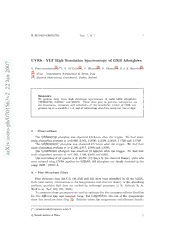
UVES/VLT High Resolution Spectroscopy of Gamma Ray Burst Afterglows PDF
Preview UVES/VLT High Resolution Spectroscopy of Gamma Ray Burst Afterglows
IL NUOVOCIMENTO Vol. ?, N. ? ? UVES - VLT High Resolution Spectroscopy of GRB Afterglows 7 0 1 ∗ 1 2 1 2 0 S. Piranomonte( )( ), V. D’Elia( ), P. Ward( ), F. Fiore( ), E.J.A.Meurs( ) 2 1 ( ) INAF - Osservatorio Astronomico di Roma, Italy n 2 ( ) Dunsink Observatory, Castelknock, Dublin, Ireland a J 2 2 2 v Summary.— 3 We present early time, high resolution spectroscopy of three GRB afterglows: 6 GRB050730, 050922C and 060418. These data give us precious information on 5 the kinematics, ionization and metallicity of the interstellar matter of GRB host 1 galaxies upto aredshift z∼4, and of interveningabsorbers along thelineof sight. 0 7 0 / h p - o 1. – Observations r t s The GRB050730 afterglow was observed 4.0 hours after the trigger. We find seven a : main absorption systems at z=3.968,3.564, 2.2536,2.2526,2.2618, 1.7729 and 1.7723 v The GRB050922C afterglow was observed 3.5 hours after the trigger. We find four i X main absorption systems at z=2.199,2.077, 2.008 and 1.9985. r The GRB060418 afterglow was observed 10 minutes after the trigger. We find four a main absorption systems at z=1.489,1.106, 0.655 and 0.602. The resolution of all spectra is R 40,000 (7.5 km/s in the observer frame). Data sets were reducedusing UVES pipeline for MIDAS. All afterglowsare clearlydetected in the range 3300 - 10000 ˚A. 2. – Fine Structure Lines Fine structure lines for CII, OI, FeII and SiII have been identified in all the GRBs. Such lines convey information on the temperature and electron density of the absorbing medium, provided that they are excited by collisional processes (J. N. Bahcall, R. A. Wolf et al. ApJ, 152, 701, 1968). Toconstraintheseparametersweneedtoestimatethefinestructurecolumndensities for two different ions and compare them. For GRB050730, two out of five components show fine structure lines (Fig. 1). Reliable values for temperature and electron density ∗ ( ) [email protected] (cid:13)c Societa`ItalianadiFisica 1 2 S.PIRANOMONTEETC. Fig.1.–ThelowionizationlinesCII,OIandSiIItogetherwiththeirfinestructureexcitedlevels inGRB050730. Lowionizationstatesandfinestructurelevelsdonotappearinallcomponents. High ionization lines CIV and SiIV havebeen taken as reference lines in the fittingprocedure. areT a few 103 K andn>104 cm−3 (secondcomponent;the components arenumbered according to decreasing z) and n ∼ 10÷100 cm−3 (third component). The other com- ponents do not show fine structure features: this is an indication that they refer to a clumpy environment. 3. – Metallicity Metallicity in GRBs can be measured comparing the column densities of heavy el- ements to that obtained for hydrogen by fitting the Ly−α, β and γ profiles. Both for GRB050730andGRB050922C,wefindmetallicitiesbetween10−3 and10−2 withrespect to the solar values. Sincemetalstendtoformdust,thatthendoesnotcontributetothe absorptionlines, this result is affected by some uncertainties. In GRB060418 we identify CrII and ZnII lines. Such elements tend to stay in the gas state, minimizing the uncertainty when estimating the metallicity. No H features are present in this GRB spectrum, so we derive the NH column from the X-ray data, leading to: Z(Cr) = −1.8±0.3 and Z(Zn) =−1.3±0.2,a bit higher than for the other two GRBs, but still below the solar values. 4. – Conclusions The absorption spectra of GRB afterglows are extremely complex, featuring several systems at different redshifts. Both high and low ionization lines are observed in the circumburst environment, but their relative abundances vary from component to com- ponent, indicating a clumpy environment consisting of multiple shells. Fine structure lines give information on the temperature and electron density of the absorbing medium, provided that they are excited by collisional effects. Different com- ponents have different densities, suggesting a variable density profile. Metallicity can be derived from the metal column densities; CrII and ZnII are the best indicators, since they do not form dust. Metallicity values around 10−2 with respect to the solar ones have been found. More details can be found in V. D’Elia, F. Fiore, E.J.A Meurs et al. 2006 (submitted to A&A, astro-ph/0609825, 2006).
